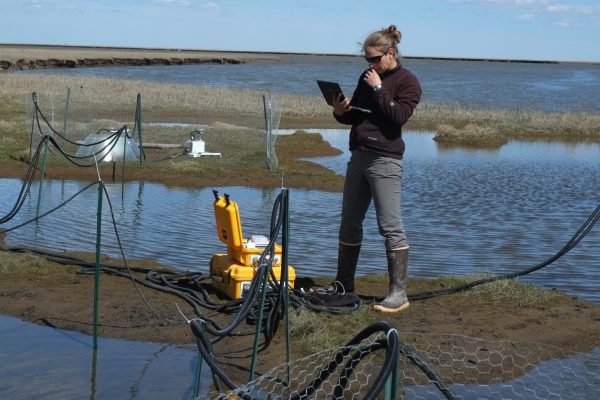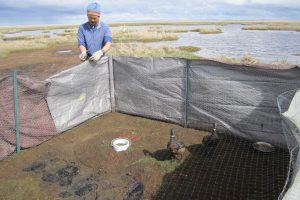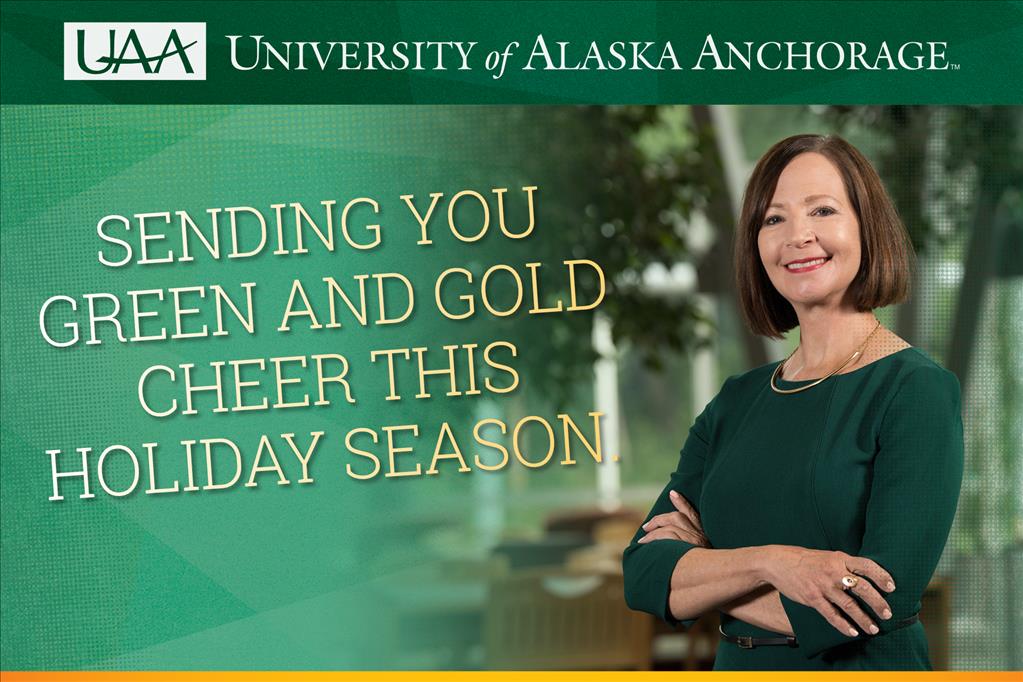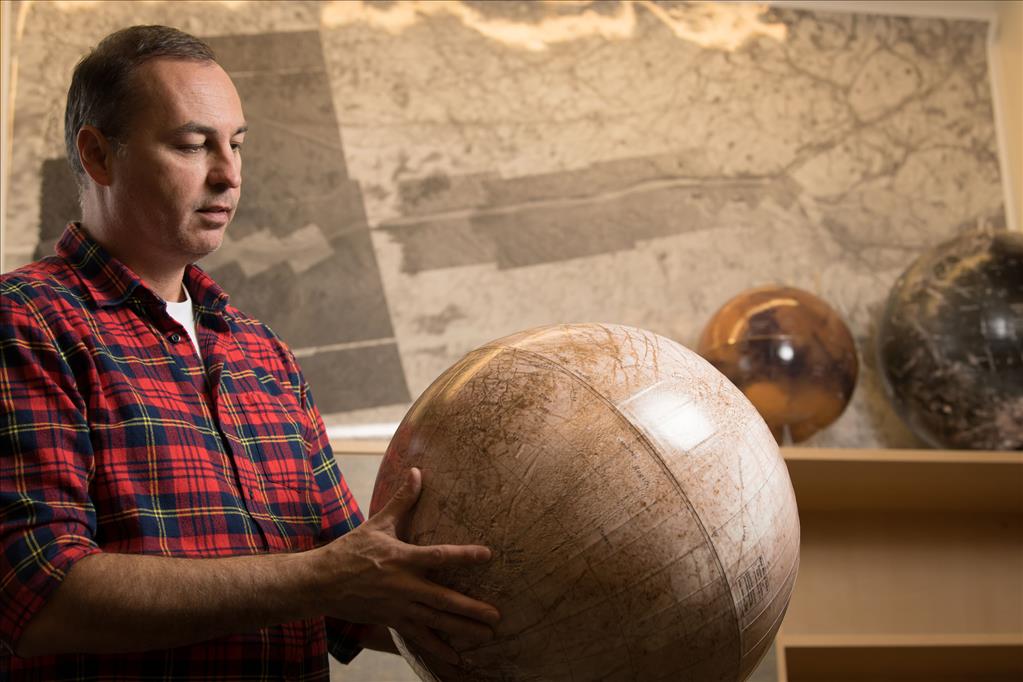Researching the effects of climate change in coastal western Alaska
by Matt Jardin |

UAA postdoctoral researcher Dr. Katharine Kelsey spent three summers in the Yukon-Kuskokwim Delta with researchers from Utah State University and South Dakota State University studying the phenomenon known as phenological mismatch and how that affects the emission of greenhouse gases. (Photo courtesy of Jeff Leffler / South Dakota State University)
Being the early bird may no longer be enough.
In many of the world's northern regions, the effects of climate change are occurring more rapidly. One of the several ecological responses include an advancement to the growing season - essentially an earlier start to spring.
Warmer weather earlier in the year sounds like a welcome prospect for many Alaskans. However, a team of researchers including postdoctoral researcher Dr. Katharine Kelsey and principal investigator Dr. Jeffrey Welker from UAA, principal investigator Dr. Joshua Leffler from South Dakota State University, lead principal investigator Dr. Karen Beard from Utah State University and Dr. Joel Schmutz of the USGS Alaska Science Center have partnered to investigate how the effects of climate change can contribute to a phenomenon known as phenological mismatch.
Phenology refers to the cyclical occurrence of natural events, particularly as it relates to climate, plants and animals. Phenological mismatch, then, is when the phenology of two species that rely on each other becomes offset.
In this particular case, researchers have noticed that the vegetation in coastal western Alaska is growing sooner in response to spring's earlier arrival. That phenology historically has matched the phenology of the Pacific black brant geese that migrate to the region every summer to procure high quality forage as they build nests, hatch eggs and care for their goslings before leaving again in the fall.
While scientists are already exploring how phenological mismatches can influence herbivore populations like the Pacific black brant geese, what isn't being looked at as thoroughly is the potential impact mismatches can have on greenhouse gas emissions.
"What we're asking is how are mismatches changing the natural processes that take up or release heat-trapping gases?" explains Kelsey. "Carbon dioxide, methane, nitrous oxide - these are gases that we know of because of their contributions to climate change and are constantly being exchanged naturally in our ecosystem."

Researchers set up camp at the mouth of the Tutakoke River. Only accessible via floatplane or boat in the summer or by snowmachine during the winter, the site is one of six major colonies of Pacific black brant on the Delta. (Photo courtesy of Katharine Kelsey / UAA Department of Biological Sciences)
To study the developing mismatch and the relationship with greenhouse gases, researchers spent the last three summers camped out on the mouth of the Tutakoke River located in the Yukon-Kuskokwim Delta. Only accessible via floatplane or boat in the summer or by snowmachining over the frozen rivers during the winter, the campsite is known for being one of six major colonies of Pacific black brant on the Delta, making it an ideal location for studying the species since the '80s.
For their fieldwork, the team designed an experiment using small open-top greenhouses capable of heating the surface of the soil to simulate what it would be like in the area with the warmth of an earlier spring arrival. Captive geese then grazed in these same areas in order for researchers to observe their grazing patterns under different levels of climate change. And if the idea of wrangling geese in an open enclosure sounds difficult, Kelsey says they're actually willing participants.

Utah State University graduate student Ryan Choi working on one of the open-top greenhouses used to observe the grazing patterns of Pacific black brant geese during different climate change scenarios. (Photo courtesy of Katharine Kelsey / UAA Department of Biological Sciences)
"It turns out that you can actually do this more easily than you'd think," she mentions. "After the geese arrive in the Delta, they know they're not going anywhere for the whole summer. They're going to be there to raise goslings so they actually molt their flight feathers, so it's not too difficult to keep them in one place."
Researchers found that plants that started growing earlier in the year - which is the scenario expected with further climate change - were able to grow larger before being clipped down by the arrival of geese. The larger size of these plants meant an overall increase in the greenhouse gases they were able to "breathe in," resulting in less heat-trapping gases being released into the atmosphere during the summer.
"What we're seeing is that in the most likely scenario, this ecosystem will probably thwart the rate of climate change because we're uptaking more greenhouse gases. So purely from that perspective, that would be good," reveals Kelsey, before cautioning, "but the whole picture becomes a little more complicated when we zoom out because there's going to be changes to the quality of forage for the geese. In general, we're seeing that as the plants grow bigger, they're actually not as nutritious. The point being that these things are always complex."
Even though the three years of fieldwork are complete, the team has a long road ahead as they are still in the early stages of analyzing the data they've collected. But if their preliminary findings are any indication, they have a lot to look forward to.
"One of the big contributions of this project is that now we know there's the potential for phenological mismatches to change greenhouse gas budgets and uptake," says Kelsey. "Before we didn't have any scientific research showing us that a mismatch of this nature can change the uptake of heat-trapping gases."
She continues, "the next steps for us is to get all the results of this research out there so that other scientists can see what we've done and incorporate that into what they're doing. Right now as a group, our goals are to really put our effort into pulling all of the data we have, publishing that and getting sound footing to start addressing our next questions."
Many of those next questions are both local and global. It still remains to be seen if the developing mismatch ultimately benefits or hurts the migrating population of Pacific black brant geese, but what does that mean for the indigenous peoples who rely on them for subsistence? Furthermore, what can these findings tell us about our atmosphere in the future, and what can we as a society do to adapt to the changes we foresee coming?
According to Kelsey, piecing the puzzle together and forming those questions is the exciting part.
"A cool thing about this research is elucidating this connection between everything we see growing on the ground and the atmosphere - they're in constant communication. It's not something we can see, so it's a difficult thing to describe or remember is happening. But that connection between the ecosystems and the atmosphere is really important to our lives."

The field team consisted of researchers from UAA, Utah State University and South Dakota State University, including (from left): Kaj Lynoe, Mike Sullivan, Thomas DeMasters, Kathy Kelsey, Lindsay Carlson, Ryan Choi and Josh Leffler. (Photo Courtesy of Ryan Choi / Utah State University)
This project is one of several addressing the interactions between herbivore-vegetation-ecosystem processes in the Arctic lead by Dr. Welker, UAA Department of Biological Sciences professor and UArctic Research Chair. Complementary studies of Dr. Welker's program include: Svalbard reindeer diets in Norway, herbivore effects on alpine tundra trace gas exchanges in the Rocky Mountains, central Arctic caribou herd landscape processes, and how reindeer grazing history effects ecosystem responses to changes in winter snow in Finland. More information on those projects can be found here.
Written by Matt Jardin, UAA Office of University Advancement
 "Researching the effects of climate change in coastal western Alaska" is licensed under a Creative Commons Attribution-NonCommercial 4.0 International License.
"Researching the effects of climate change in coastal western Alaska" is licensed under a Creative Commons Attribution-NonCommercial 4.0 International License.














